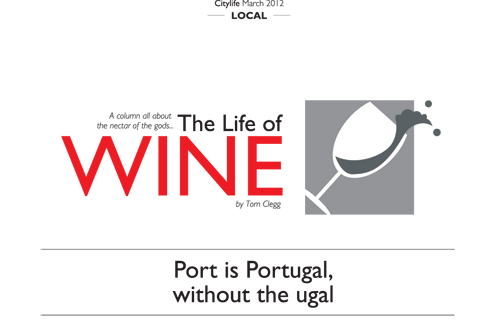
Wine should never be scary
Dear reader, it appears I have some rather large flip-flops to fill taking over this column and would like to use the opportunity to thank Jon Hyams for his accessible and extremely informative pieces on what are frankly huge subjects in the wine world – such as Champagne vs. sparkling wines and the continuously contentious subject of why so many wine producers hang on to using cork as a closure of choice.
Before moving out to Chiang Mai I worked in the British wine industry where I met some amazing characters and was privileged enough to taste some of the most wonderful examples of what a grape can become when lavished with extraordinary dedication and love. I hope I can convey some of the enthusiasm that has infected me over the coming months.
Wine can be mind blowing. It is also just an alcoholic drink. It can provoke profound responses in every sense, whether it is the artwork on a bottle of Mouton Rothschild by the twentieth century’s greatest painters from Picasso to, erm, Prince Charles; the first time one realises they really can smell pencil shavings and their grandad’s leather shoes in a glass of Bordeaux out of the barrel; the surprise that a gulp of vintage champagne really does taste like digestive biscuits or that Petrus ’83 is an extremely expensive reminder of a cup of cold hot-chocolate.
It is, as I said, also just a drink. I repeat this because wine can be needlessly daunting. I still remember the panic of my first big wine tasting. I was fortunate enough to be presenting wines from some of the greatest producers on the planet and I was petrified. Was Sori Tilden a single vineyard Barbaresco? Was it aged in small or large oak casks? And the Cabernet Sauvignon, when did Anjelo Gaja start defying his father by growing the bloody Cabernet Sauvignon? I was a mess and pretty sure that Mr Gaja would fly over from Italy and string me up if I got it wrong.
But all of this doesn’t matter and is literally pointless information to be giving out anyway. I quickly learnt that tasting wine under any sort of pressure is a fruitless exercise (excuse the pun, if it can be classed as one). I quickly gravitated to those tasters who had come not to ask ludicrous questions about rainfall on the upper slopes of the Rhone in 2004 but who wanted to know just a little more about the wines they quite simply enjoyed drinking. I became ecstatic when I was asked by a couple if there was any way they could find out if a wine they drank on their wedding day 30 years previously was still available: that was an important question.
Wine is also about memories. Whether it was that burgundy drunk in a small cafe as the sun set over Paris, or that bottle of champagne your father put aside until your eighteenth birthday – a great bottle of wine opened at a special time very rarely elicits a bad memory (Mad Dog 20/20 and Thunderbird excepted).
So, those of you who know all there is to know about the grape have probably given up reading this already. But I’m interested in the rest of us. I hope what I can deliver is encouragement. Encourage- ment to crack open a bottle of wine you haven’t tried before, take it round to a friend’s house for dinner, or attend an informal wine tasting and say what you think. Everything is relevant when it comes to wine and there is really no way you can have a wrong opinion. Obviously, if you are getting hints of tobacco from a glass of Chablis, you should probably put the fag out. Other than that it’s your nose, it’s your palette and it’s your opinion.
If wine isn’t fun then you are drinking it in the wrong place, with the wrong people or in rehab. There are many people in the ‘wine industry’ who have a vested interest in bamboozling and who enjoy the sound of their own voice. I hope that’s not me, and I welcome any questions you have. If I don’t know the answer, I certainly know how to find out. So, thank you once again to Jon for his work over the past months and I look forward to seeing many of you at the events being organised by Citylife.
And, the obligatory quote: ‘Good wine needs no bush’ – William Shakespeare. I have no idea what he’s on about.
Sauvignon Blanc – Perfect for the
hot season, perfect with Thai food.
• Momo Seresin 2009 – 1,600 baht – Wine Connection
Marlborough, New Zealand
Seriously gorgeous. Lively, fruity, flinty nose with rich tropical fruit, gooseberries and a zesty spiciness in the mouth. Well balanced, lengthy, herbal finish.
• Paua Bay 2009 – 699 baht – Wine Connection
Marlborough – New Zealand
Gooseberry, lemongrass, pineapple, and passion fruit. Creamy texture with lively acidity and a good finish.
• Wairau River 2009 – 990 baht – Wine Gallery
Marlborough – New Zealand
Grapefruit and passion fruit. Crisp, underlying minerality. Lingering finish of pear and black currents.
• Fox Creek 2007 – 850 baht – Wine Gallery
MacLaren Vale – South Australia
Citrus blossom, lemongrass and a hint of herb on the nose. Gooseberry and melon with a zesty finish. Still holds up, though younger vintages will be livelier.
• Aresti Art – 999 baht for 3 litres
.
Curico Valley – Chile
Yes, it’s in a box, but that means there’s more of it. Chilean Sauvignon Blanc is getting better and better and the Aresti family are no slackers. Crisp, light and citrusy; this will go perfectly with any Thai food thrown on the BBQ.
Feel free to email us your questions or comments to wine@city-wine.com .